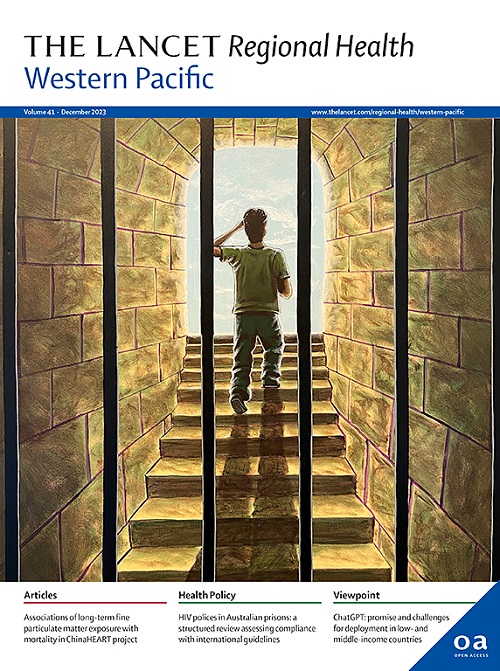Mapping the prevalence of soil-transmitted helminth infections in the Western Pacific Region: a spatial modelling study
IF 8.1
1区 医学
Q1 HEALTH CARE SCIENCES & SERVICES
引用次数: 0
Abstract
Background
Soil-Transmitted Helminth (STH) infections are a significant health issue in the Western Pacific Region (WPR). This study aims to produce high-resolution spatial prediction STH prevalence maps for the WPR.
Methods
Bayesian model-based geostatistical frameworks were developed for each STH species (Ascaris lumbricoides, Trichuris trichiura, Strongyloides stercoralis, and hookworm) to estimate infection prevalence at a spatial resolution of 1 km2. A systematic review created a comprehensive database of STH prevalence surveys, which informed the geostatistical frameworks. Logistic regression models incorporating both fixed covariate effects and spatial random effects were applied to identify drivers of spatial distribution for each species.
Findings
We analysed 227 surveys from 3122 locations across 15 countries in the WPR. Between 1998–2011 and 2012–2021 substantial reductions in the pooled prevalence of hookworm (21.3%–3.7%), A. lumbricoides (21.7%–6.5%) and T. trichiura (22.5%–9.7%) were observed, while S. stercoralis prevalence increased (13.3%–18.4%). High-resolution spatial prediction maps revealed notable geographical variations in STH prevalence, with persistent hotspots identified in China, Cambodia, Malaysia, and Vietnam. Altitude and distance to health facilities were positively associated with the prevalence of hookworm and A. lumbricoides, while sand content in soil was positively associated with all STH species. In contrast, coarse soil fragments and organic carbon content were negatively associated with the prevalence of T. trichiura and A. lumbricoides.
Interpretation
The high-resolution spatial prediction maps produced in this study can inform resource prioritization to accelerate STH elimination efforts.
Funding
National Health and Medical Research Council (1153727 ACE-NTD).
绘制西太平洋地区土壤传播蠕虫感染流行情况:一项空间模型研究
土壤传播蠕虫(STH)感染是西太平洋地区(WPR)的一个重要卫生问题。本研究旨在为WPR制作高分辨率空间预测STH流行图。方法建立基于贝叶斯模型的地质统计框架,对每一种STH物种(蚓蛔虫、毛滴虫、粪圆线虫和钩虫)在1 km2的空间分辨率上估计感染流行情况。有系统的检讨建立了一个有关STH流行调查的综合数据库,为地质统计架构提供资料。采用包含固定协变量效应和空间随机效应的逻辑回归模型来确定每种物种空间分布的驱动因素。调查结果:我们分析了《世界卫生报告》中15个国家3122个地点的227项调查。1998-2011年和2012-2021年期间,钩虫、蚓类伊蚊和毛虫总流行率均显著下降(21.3% ~ 3.7%),而粪虫总流行率上升(13.3% ~ 18.4%)。高分辨率空间预测地图显示,STH流行的地理差异显著,在中国、柬埔寨、马来西亚和越南发现了持续的热点。海拔高度和到卫生设施的距离与钩虫和类蚓虫的流行率呈正相关,而土壤中含沙量与所有类蚓虫的流行率呈正相关。粗粒土壤碎片和有机碳含量与毛螺旋体和蚓状螺旋体的流行率呈负相关。本研究生成的高分辨率空间预测图可以为资源优先排序提供信息,以加快消除STH的工作。资助国家卫生和医学研究委员会(1153727 ACE-NTD)。
本文章由计算机程序翻译,如有差异,请以英文原文为准。
求助全文
约1分钟内获得全文
求助全文
来源期刊

The Lancet Regional Health: Western Pacific
Medicine-Pediatrics, Perinatology and Child Health
CiteScore
8.80
自引率
2.80%
发文量
305
审稿时长
11 weeks
期刊介绍:
The Lancet Regional Health – Western Pacific, a gold open access journal, is an integral part of The Lancet's global initiative advocating for healthcare quality and access worldwide. It aims to advance clinical practice and health policy in the Western Pacific region, contributing to enhanced health outcomes. The journal publishes high-quality original research shedding light on clinical practice and health policy in the region. It also includes reviews, commentaries, and opinion pieces covering diverse regional health topics, such as infectious diseases, non-communicable diseases, child and adolescent health, maternal and reproductive health, aging health, mental health, the health workforce and systems, and health policy.
 求助内容:
求助内容: 应助结果提醒方式:
应助结果提醒方式:


